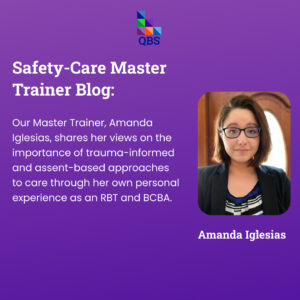A Personal Journey into ABA
In 2017, I began working in a clinic/school that utilized Applied Behavior Analysis (ABA), which involved stepping into a field that I had not planned for but quickly grew passionate about. ABA offered me a framework to turn my observational nature into something meaningful. ABA made sense to me, and working with individuals with varying abilities and diagnoses quickly became something I loved.
Just a year later, I enrolled in a master’s program and began the journey to becoming a BCBA, earning my certification in 2020. Since then, I’ve worked in homes, schools, and clinics with clients across the spectrum: verbal, nonverbal, and those with complex diagnoses. Each setting taught me something new about the importance of individualized care, consent, assent, and, most importantly, trust.
Learning from Experience: Lessons from the Floor
My understanding of autism changed entirely when I first began as a Registered Behavior Technician (RBT). The training I received was adequate enough to understand what ABA was, however, my role as a practitioner fundamentally changed when I worked with a young nonverbal child during my early days as an RBT. I saw firsthand how behavior, sometimes extremely challenging, was often a result of being unable to communicate.
This child taught me the importance of following a client’s lead. I remember getting on the floor drawing and singing with her. That small act of joining her world, at a level she allowed, changed everything in our sessions together. She began to trust me, and from there, she began to communicate. I immediately saw the difference between my approach with her versus that of others. That experience showed me what happens when you build a relationship before trying to “teach.”
In ABA, we often talk about assent and consent as ethical obligations, which while they absolutely are, also hold the key to meaningful progress. Assent isn’t just a checkbox; it’s a continuous process of listening, observing, and respecting boundaries. As Taylor, LeBlanc, and Nosik (2019) note, ethical ABA is grounded in client dignity and autonomy. That means honoring nonverbal cues, giving clients choices, and understanding that “no” means “no.”
Context Matters: Settings and the Meaning of Consent
Working across different settings showed me how the context changes not only what we focus on, but what is meaningful to the individual in that moment. In schools, we might focus on social interaction, following group instruction, and peer inclusion. At home, daily living and communication is often the focus, and in clinics, it’s about skill-building and generalization. No matter the setting, consent and assent guide every step. Assent is more than compliance; it means the individual is willing, engaged, and participating. The setting might change what’s meaningful to the individual, which is another important factor to understand when utilizing ABA. Assent is dynamic, requiring us to continuously observe, listen, and adapt.
It wasn’t until I learned about trauma-informed care that I really began to understand why some clients took longer to warm up. Rajaraman, Hanley, and Copeland (2022) discuss how trauma can shape how individuals respond to interventions. What’s also important to recognize is we may not always be aware of a person’s trauma history, especially when it comes to individuals who cannot always communicate verbally. If we rush the process or ignore signals of discomfort, we risk re-traumatizing the people we’re trying to support. Ford and Courtois (2020) emphasize that trauma-informed care requires us to ask the question “What happened to you?” Instead of seeing resistance as noncompliance, it’s important to see it as communication. Instead of pushing through a program, pause to ask whether the client is really on board. That pause can often make all the difference.
As behavior analysts, we have evidenced-based interventions ready to utilize but with that comes responsibility. Bottema-Beutel and Crowley (2021) caution us about the ethical pitfalls of rigid, one-size-fits-all treatments. Instead, we must be flexible, honest, and guided by respect. McGill and Poynter (2012) highlight the ethical complexity of our work and remind us that doing the right thing isn’t always clear-cut, but it starts with empathy.
Conclusion
Autism acceptance, for me, means recognizing the full humanity of the individuals we work with. It means seeing behaviors as expressions, not problems. It means understanding the daily struggles caregivers face and supporting them, too. The focus should always be on helping support individuals to be as independent as possible, whatever that means for them. That includes respecting their consent and assent.
I wish for more professionals to understand how slow and deliberate trust-building can be. ABA doesn’t always look like the textbook at first. Once you lay that foundation, rapport building with consent, assent, and trauma-informed care, it helps us, as providers, do our best work. Challenging behaviors may still occur, but our response should always begin with compassion and empathy.
References
Bottema-Beutel, K., & Crowley, S. (2021). Pseudoscience and deception in autism intervention: Recommendations for ethical practice. Behavior Analysis in Practice, 14(4), 893–901. https://doi.org/10.1007/s40617-021-00602-y
Ford, J. D., & Courtois, C. A. (2020). The essential components of trauma-informed care. American Journal of Orthopsychiatry, 90(1), 5–15. https://doi.org/10.1037/ort0000435
LeBlanc, L. A., Taylor, B. A., & Marchese, N. V. (2020). Building and sustaining meaningful and effective relationships as a supervisor and mentor. Behavior Analysis in Practice, 13(1), 88–98. https://doi.org/10.1007/s40617-019-00377-
McGill, P., & Poynter, J. (2012). ‘I just want to do the right thing’ – Ethical challenges in the conduct of applied behavior analysis for people with intellectual disabilities. Behavioral Interventions, 27(3), 171–182. https://doi.org/10.1002/bin.1343
Rajaraman, A., Hanley, G. P., & Copeland, D. (2022). Toward trauma-assumed behavior analysis: Considerations for the ethical and effective treatment of escape-maintained problem behavior. Behavior Analysis in Practice, 15(1), 141–157. https://doi.org/10.1007/s40617-021-00594-9
Taylor, B. A., LeBlanc, L. A., & Nosik, M. R. (2019). Ethical considerations for applied behavior analysis practitioners. Behavior Analysis in Practice, 12(1), 119–126. https://doi.org/10.1007/s40617-018-00275-0
About the Author
Amanda Iglesias is a Board Certified Behavior Analyst (BCBA) and Master Trainer with a passion for ethical and compassionate care. She began her career in the field of Applied Behavior Analysis in 2017 after earning her Bachelor of Science in Psychology. Inspired by the science and its impact, Amanda discovered her passion and went on to complete her Master of Science in Behavior Analysis. Amanda’s goals are to make positive changes and promote acceptance for all in the community.

 By using our site, you consent to our use of cookies to enhance functionality and analyze site performance.
By using our site, you consent to our use of cookies to enhance functionality and analyze site performance.